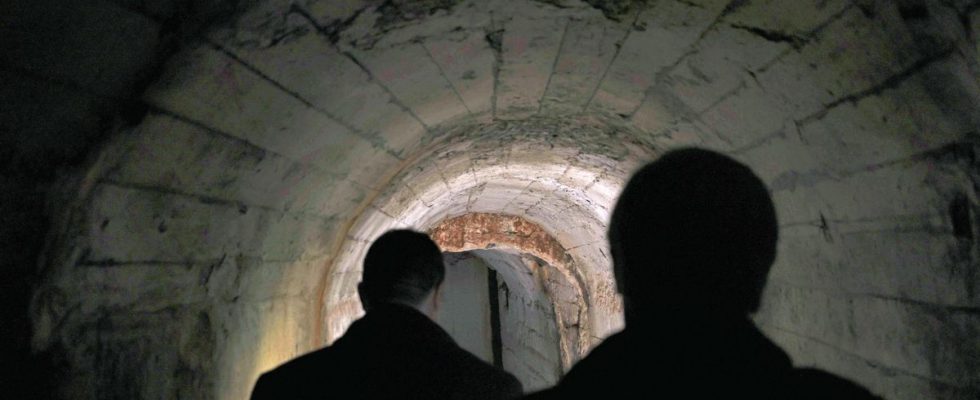“I have lived in Angoulême since I was born. And I always heard the same stories,” recalls Juliette*. Beneath our feet, out of sight, urban legends are being created and rumors are spreading. “It is said that in Angoulême, an underground network long ago allowed anyone to cross the city from side to side,” says the young girl. But a story comes back in the mouths of several Angoumoisins, including Raphaël*. “A long time ago, nuns passed through its underground passages and took their children there. At the time (and still today), nuns were not allowed to have children and it was very frowned upon. It was in these cellars that they killed their offspring,” Raphaël explains. “And even today, the spirits of these children are imprisoned there,” says Juliette, without an ounce of humor. “When you enter certain cellars, there is a heavy atmosphere,” adds Raphaël.
“These are just legends”, denies Laetitia Copin-Merlet, director of the Pays d’art et d’histoire service in Grand Angoulême. But where does this persistent rumor of child-killing nuns come from? “I have no idea,” slips us a third resident of the city. “And good luck finding the origin,” he tells us. And despite several hours of research and phone calls, 20 minutes failed to trace the origin of this old rumour.
No “labyrinth” but many cellars
“There is a kind of fantasy for the undergrounds. As soon as the inhabitants see something underground, they imagine a network,” explains Stéphane Calvet, a Angoumoisin historian. “Others say that in the Middle Ages these tunnels allowed the inhabitants of the city and the count to escape from the city in the event of an invasion”, adds Laeticia Copin-Merlet. However, according to our two experts, no, the south-west balcony does not house a communicating underground network or a “labyrinth” under the streets, as Juliette describes it. “But a very high concentration of cellars, on the other hand yes”, affirms Stéphane Calvet.
In the heart of the Charente, Angoulême, where some 42,000 souls live, is one of the oldest French cities. And between the 3rd century and today, its configuration has had time to evolve. “Several layers of dwellings have been built over the centuries. To put it simply, the cellars of the current city center are the ground floors of yesteryear. One can also see passages, galleries under the cellars of today. It is neither more nor less than the medieval cellars. This is where there can be confusion,” says Stéphane Calvet. Rooms sometimes over 700 years old, even 900 years old, which are full of architectural and historical treasures, thinks the author of the book History of Angouleme published by Geste.
An Emmental under the city
In the Middle Ages, Angoulême housed several fortified castles. The first was the count’s castle, now the town hall. Then the Châtelet, a building built at the level of the market place by the king who feared the influence of the count of the time. This last castle was destroyed in the 19th century. “For once, I’m sure that between these two places, there was an underground network,” says Stéphane Calvet. The very nature of the soft stone on which the city is built, limestone, makes it easy to dig the ground.
According to the historian, if the first 25 meters under the city were probed today, “we would have an image in the form of Emmental”. “In the heart of the city in the past, there was the Taillefer Palace. It was the first residence of the counts of Angoulême, which was built between the 10th and 11th centuries. But, today, on its ruins were built houses, which have cellars. These last are finally those of the old palace ”, describes the historian writer. These vaulted cellars now belong to individuals.
Shelters during the Second World War?
“During the Second World War, Angoumoisins were hiding in these underground passages”, also believes to know Juliette. An opinion Laetitia Copin-Merlet? “Between the beginning of the 20th century and 1950, in the city, there were five stations and around 78 railway lines. Tunnels had been built for the passage of trains but also to connect the tracks between them to allow the maintenance of the locomotives. During the Second World War, in 1944, this strategic railway junction was bombed by the Allies to halt the advance of Nazi troops towards the Atlantic.
“And yes indeed, the inhabitants took refuge in the tunnels to protect themselves”, affirms the director of the Pays d’art et d’histoire service in Grand Angoulême. Unfortunately, to the chagrin of curious people and urban explorers, the vast majority of these tunnels are now walled up.
The Angoulême tourist office confirms that many cellars and some underground passages exist near the Saint-Paul primary school, the pharmacy in old Angoulême and the residences on rue Vauban. To visit them, it will be necessary to ask the authorization of the owners of the places.
* The first names have been changed at the request of the interested parties.

